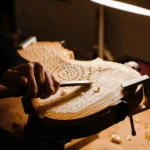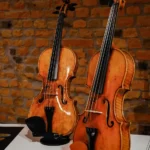Why Is The Violin So Beautiful? Understanding The Amazing Masterpiece
Back to BlogWhy is the violin beautiful? How did it engage so many people? A tiny piece of wood, strings and some other things, the violin plays more than just music. It helps people connect. It’s a musical masterpiece that has stood the test of time. The violin has had an extremely important role in the spread of music throughout history. The influence that this instrument has had on society is almost immeasurable. In fact, it is hard to hear one of these instruments without experiencing some powerful emotion of love or sadness.
Maybe the reason why the violin is so engaging comes from centuries ago
The history of the violin can be traced back as far as the 9th century; however, most violins are associated with Europe. Musicians such as Fritz Kreisler, Jascha Heifetz, and Niccolo Paganini are three of the most famous violinists in the world. The current form of the violin evolved more than 500 years ago from several musical instruments, including a lute-like instrument called a fiddle.
The Luthiery History
The art of creating stringed instruments flourished in Cremona in the mid–16th century. Andrea Amati, who began making stringed instruments there, and his students attracted international attention. Sadly, as the century closed, Cremonese luthiers were eclipsed by makers from other Italian towns and cities, but their legacy was revived in the 20th century.
Nowadays, Italy carries the badge of the finest instrument makers in the world. The Cremona Liuteria guarantees the authenticity of an instrument crafted by a committed luthier, whose personality and individual style are evident in each of his creations.
When the luthier makes your masterpiece, he has a reason for everything he does. It requires immense skill and precision. A handmade violin is a carefully crafted instrument with a distinct personality that no factory-made violin will ever be able to mimic. Handmade violins are definitely better because of the craftsmanship and expertise they take to build, that’s why we call them a masterpiece.
To make a fine instrument, a luthier must start with good materials and work carefully. Consequently, the violin will have an incredible tone. You should be aware of this because the more you know, the more likely it is you’ll find the right instrument for your musical purposes.
The Beautiful and Loved Voice Across Time And Space
The violin has been loved by many, both young and old people. This stringed instrument can produce a number of beautiful sounds and melodies. Beethoven, Tchaikovsky, and Bach have all written works for solo violin that have been performed with great success by musicians such as Itzhak Perlman and Hilary Hahn.
Instruments such as the piano developed over time, but the violin is virtually identical to its modern form. Differences in sound holes and other physical attributes depended on the maker and their musical motivation.
The making of the masterpiece
Consisting of a wooden body, it has two f-holes and a bridge. The bridge is used to connect the strings from one half of the body to the other. The strings themselves can be made out of gut, metal, or synthetic core hybrid. Also, a scroll is sticking out from the end of the fingerboard.
The bridge transfers some of the sound energy from the vibrating string to the violin’s wooden body. According to studies, the bridge is best at transmitting power at high frequencies, which makes sense because that is where humans’ ears are most sensitive.
Therefore, it might be one reason the violin is such a great instrument. You can make it quieter and less powerful by placing a weight on the bridge — the weight is called a mute, and it’s typically made of felt, leather or cork. Pointed out by the Illumin Magazine.
The bow produces the violin’s distinctive sound by pulling the wires back and forth. Although it doesn’t seem to be that important, the bow actually makes a big difference in the sound and playability.
The soundpost is a small, rounded, tapering cylinder placed near the bridge on the treble side and acts as a support for the top plate. It transfers the vibrations to the backplate, turning the violin’s body into a resonant box. The soundpost is the most important part of a violin since it is responsible for producing the sound. The violin strings are stationary, but the soundpost must be adjusted in order to establish an ideal tension.









